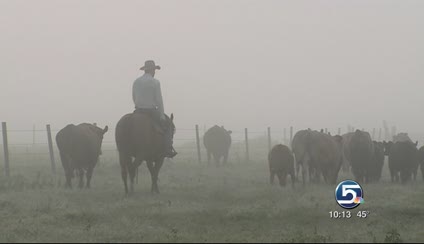Estimated read time: 3-4 minutes
This archived news story is available only for your personal, non-commercial use. Information in the story may be outdated or superseded by additional information. Reading or replaying the story in its archived form does not constitute a republication of the story.
ST. CLOUD, Fla. — Most Utahns are unaware that The Church of Jesus Christ of Latter-day Saints owns one of the biggest ranches in the country — and it's nowhere near the Beehive State.
Because of its prominent location, millions have seen the ranch without realizing what it was. But managers are opening the curtain; they have a message they want the public to hear.
Orlando Airport: 10 miles
Kennedy Space Center: 15 miles
Magic Kingdom: 22 miles
The cowboys are up before dawn, but this is not the Old West.
They ride out into Florida fog to punch cows — a lot of cows. In all, there are 44,000 of them, producing over 30,000 calves each year.
"It's good cattle country. At times it can be a hard environment to run cattle in," said David Genho, cattle development manager at the Deseret Cattle and Citrus Ranch.
Over the decades, the cattle have been specially bred at the ranch to thrive in a tropical climate.
Along with the cattle, the ranch has groves and groves of citrus fruit. Every year, it produces enough oranges to make 50 million glasses of orange juice.
- 500 billion gallons of rain fall the ranch receives annually (1.5 times the volume of Utah Lake)
- 290-300,000 acres (450 sq. miles)
- 165,000 acres of pasture land
- 75,000 acres of wetlands
- 60,000 acres of timber
- 1,700 acres of citrus orchards (producing 50 million 8 oz glasses of orange juice annually)
- 920 acres of row crops (450 acres of potatoes for Frito Lay Chips)
- 33,000 calves born annually
- 1,400 bulls
- 1,400 miles of fencing
- 380+ documented species of vertebrate animals- many threatened or endangered
- 245 birds
- 53 fish
- 33 reptiles
- 31 mammals
- 20 amphibians
- 61 years of operation (acquired in 1950)
- 45 hunting clubs have rights to use land
But there's also a profusion of wildlife. To see it all you have to walk through jungles, or take a wild ride on an airboat across a thriving aquatic habitat — where you run a pretty good chance of getting crossways with an alligator.
"Occasionally they'll take a calf; and just last week one of our cowboys had his favorite dog that went down to get a drink and … that was the last of him," said David Wright, environmental affairs manager at the ranch.
The Church of Jesus Christ of Latter-day Saints acquired the property in 1950, and Florida grew up around it.
"Just the scale of it is hard to grasp," said environmental consultant W. Michael Dennis. "We're in this remote area, but yet it's still very close to all the urban centers of central Florida."
It's not far from Disney World, for one. It covers nearly 300,000 acres — more than 450 square miles spanning much of the distance from the Orlando airport to the Kennedy Space Center.
Urbanization is creating challenges "with the pressures for water, the pressures for land, the pressures for transportation corridors," Dennis said.
As legal and political controversy rises over those issues, ranch managers are now proudly displaying what they've done for the environment.
"The ranch has been a good steward of this land for 60 years," Dennis said.
The ranch won a Florida environmental leadership award for creating a one square mile wetlands reservoir to purify storm water runoff.
"The natural wetland vegetation takes up any nutrients that are found in the water; the nutrient levels are already very low," said Erik Jacobsen, general manager of the ranch.
The reservoir is now a haven for wildlife. "We've documented over 380 species on the ranch. Some are protected and some are rare," Jacobsen said.
They created a rookery, a nesting area, for thousands of birds by re-landscaping. It created island sanctuaries protected from predators by a moat full of alligators.
"We want to protect the environment; and that's been part of our responsibility since we've been here," Genho said.
On a broad scale, they've achieved an award-winning stewardship approach with a carefully designed mosaic of wetlands, pasture and timberland.
"Just the nature of our ranching operations is a huge benefit to the surrounding area because of the diversity of habitat it creates for wildlife," Jacobsen said. "It creates a huge area for groundwater recharge."
Rather than pumping precious groundwater, ranch managers capture and use surface water almost entirely. The ranch is currently battling a lawsuit that's aimed at turning over some of that water to surrounding communities.
"I think through cooperation we can come up with solutions that will be able to sustain the water supply in the area for years to come," said James Payne, manager of properties at the ranch.
Recently the ranch was honored for its environmental stewardship of the land. It won a "best in the region" award from the National Cattlemen's Beef Association.
---










